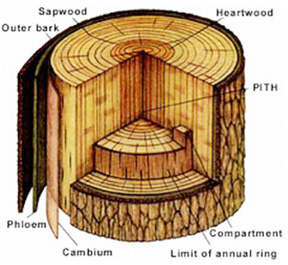Chesapeake Bay's Independent Newspaper ~ Since 1993
1629 Forest Drive, Annapolis, MD 21403 ~ 410-626-9888
Volume xviii, Issue 11 ~ March 18 - March 24, 2010
Home \\ Correspondence \\ from the Editor \\ Submit a Letter \\ Classifieds \\ Contact Us
Best of the Bay \\ Dining Guide \\ Home & Garden Guide \\ Archives \\ Distribution \\ Advertising![]()


Bay Gardener |
Repairing Winter’s Damage
Watch for rascally rabbit damage
The snow covered most of the food rabbits feed on during the winter months. Hungry, they turn their sharp teeth on the bark at the base of plants. If they’ve removed the bark from all around the trunk of a tree or shrub, the top of the plant will die.
Death follows because in the process of eating the bark, rabbits will also be eating the cambium layer, the green layer just beneath the bark, which is rich in nutrients. The layer of tissues between the bark and the cambium is called the phloem. The phloem cells are primarily responsible for conducting water and nutrients up the stem. The loss of this layer of cells means that the top of the plant will die for lack of water as soon as growth resumes in the spring.
Since the rabbit ate both bark and cambium, the plant is no longer capable of generating new phloem cells.
 U
U![]() nless you carefully inspect the base of the plants now, you are unlikely to notice any damage until late spring. The damaged plants will resume normal growth as soon as growing conditions are appropriate, using the water and nutrient reserves stored in the stem. However, as soon as day temperatures reach the 80s, the plants will begin to wilt. The plants will appear normal in the morning but will be wilting by mid-afternoon.
nless you carefully inspect the base of the plants now, you are unlikely to notice any damage until late spring. The damaged plants will resume normal growth as soon as growing conditions are appropriate, using the water and nutrient reserves stored in the stem. However, as soon as day temperatures reach the 80s, the plants will begin to wilt. The plants will appear normal in the morning but will be wilting by mid-afternoon.
What to do?
If you see wilting, examine the base of the plant. If the bark appears to have been chewed away all around the stem, you have positive proof that the plant has been girdled and its top is dead.
If only part of the stem has been girdled, prune out the dying branches and prune away at least half of the remaining stems and branches on a partially girdled portion. If the plant is a deciduous or broadleaf evergreen, it will sprout new stems and grow rapidly. If the plant is a conifer such as pine, spruce, fir, false cypress, arborvitae, hemlock or juniper, you might as well cut it down and replace it.
Ask Dr. Gouin your questions at [email protected]. All questions will appear in Bay Weekly. Please include your name and address.
© COPYRIGHT 2010 by New Bay Enterprises, Inc. All rights reserved.
